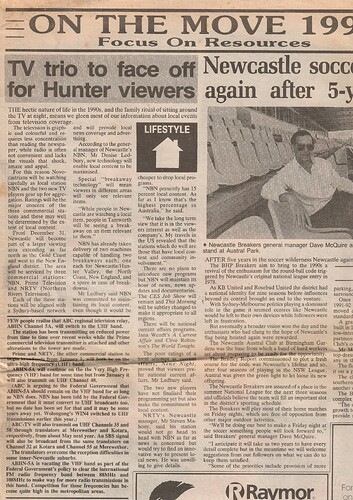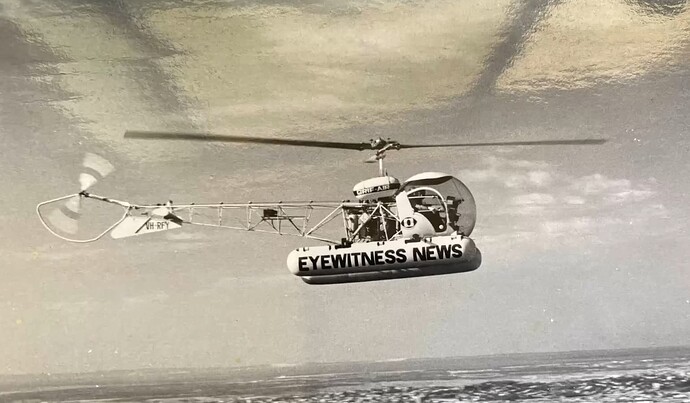Where did u find that? ![]() Given that it references 2JJ I’d say it’s from late 1970s?
Given that it references 2JJ I’d say it’s from late 1970s?
I think Allan Humphries in that pic is Mark Humphries’ dad.
On the back of the UBD New England Region Business and Tourist Guide from 1980.
Was pleased to see recently that great Aussie actor (and a brilliant one at that - could play a great gritty cop or a thug bad guy) Gerard Kennedy is alive and well, over 90 now! Kept acting into his 70s, even 80s, often guest in shows like Blue Heelers later on and Underbelly as late as 2014. A two-time Gold Logie winner and star of Nine-Crawford’s Division 4 back in the 70s.
Here’s a pre-aggregation (1991) article from the weekly ‘The Star’ in Newcastle regarding the new stations (and ABC 5A broadcasting on UHF).
The final paragraph of that is, of course, obviously correct in NBN’s case but wasn’t entirely in the ABC’s, given 5A was up in the ~137-138 MHz band, nonetheless being used by increasing numbers of satellites and such. That said, given how long WIN SA were seemingly able to hold onto 5A despite a deep push to get them off there for the same reason, that was probably a lesser priority than clearing the 88-108 band, so perhaps the ABC had a point.
Interesting that certain Band II stations never had to vacate their heritage channels, e.g. NBN3, SSW3, ABSW5, GTS4, etc. Newcastle and Bunbury I would have thought would have been more than necessary to clear room for the FM band as early as possible given their proximity to major capital cities, but for some reason they never needed to until the analogue shutdown. Whereas others like WIN4, ABC3, ABGV3, ABRV3, ABLV4, AMV4, all moved off very early on.
I suppose GTS4 and RTS5A probably were less of a priority being in more isolated regions.
NBN-3 took the ABA (now ACMA) to court and won arguing it should be allowed to remain on VHF-3. It may have been that the ABA simply didn’t try to force any more moves after that decision.
i wonder on what grounds NBN won the case? I might have to do some googling ![]()
Yes I don’t know how/why! I’m curious too…
I can’t find any specific things through an AustLII search that actually went to… probably would have been the AAT on this, although there is at least one AAT mention in 1991 that NBN TV’s solicitor made, relating to a review of documents the govt at the time was trying to keep exempt from FOI or something. ![]() Nor did looking at annual reports of the ABT/ABA or the Department provide a huge number of clues.
Nor did looking at annual reports of the ABT/ABA or the Department provide a huge number of clues.
some partial conjecture ahead…
Basically the policy as I understand it was to move them off “if there was radio demand”, and it’s possible that NBN were simply able to delay it enough - arguing enough about the lesser reach of a UHF service as opposed to VHF 3, and maybe lack of radio demand - for a change in regime (when the 1992 Broadcasting Act came in and the ABT was replaced with the ABA in October) to become slightly lighter-touch.
So it might have went to the AAT but the department backed down before the case came down with a decision? Hard to know.
It was something explicitly pointed out during a DMG Radio submission to a Productivity Commission inquiry in 1999; who had a vested interest as a number of FM licences were being auctioned at the time, notably the licences that’d eventually become Nova, as well as Star FM in Gosford. Perhaps some deep frustration that they couldn’t move into Newcastle too, given they explicitly called out NBN’s allocation as part of its mention about the tardy Band II clearance.
Wollongong probably happily moved, partly because the effects were likely minimal with a transmitter on the escarpment - but also because WIN TV was enough of a vested interest, being able to convert 2OO into i98, right into the slot where VHF 4 sat (of course, 2WL/Wave FM was moved there too).
Searches also found a 1994 Honours thesis from Edith Cowan uni that mentioned how GWN were able to stave off a similar fate for their Bunbury station on channel 3, which was due to move in 1993 - by giving the authorities an ultimatum that if UHF conversion was forced on them, they couldn’t also sustain their satellite service. (While also noting, of course, that until the late 80s they also owned the solus radio station in town in 6TZ, before it was spun off into RadioWest…)
Wollongong also had WIN-3 Brokers Nose which broadcast right through until analogue shutdown too. I guess it was able to stay given NBN was still there as well, so turning it off/to UHF didn’t solve the Sydney basin FM band congestion problem alone?
I guess you could argue that VHF 3 didn’t save a whole lot of spectrum (4MHz of a 20MHz band), whereas VHF 4 and 5 consumed a whole 7MHz channel and had far greater impacts to FM radio.
I did realise that after typing that out, that channel 3 would’ve been less of a problem than 4 and 5 for that reason. You’re quite right on that fact.
True, but 4 mhz is still effectively 5 high power frequencies for one market, nothing to be sneezed at either.
Oh I don’t disagree, especially in a congested area like Newcastle/Sydney/Wollongong. I guess the point was more that in the early 1990s when band congestion was less an issue, it would have been easier to argue that Channel 3 caused fewer problems to FM radio rollout than Channel 4 (or 5) would have.
Interesting history of news gathering by helicopter in Brisbane by Peter Doherty
The first news helicopter in Brisbane 1977
He discusses how important it was to have a helicopter in the opener for news bulletins in the past.
Forget helicopters, what about the speed boats ![]()




